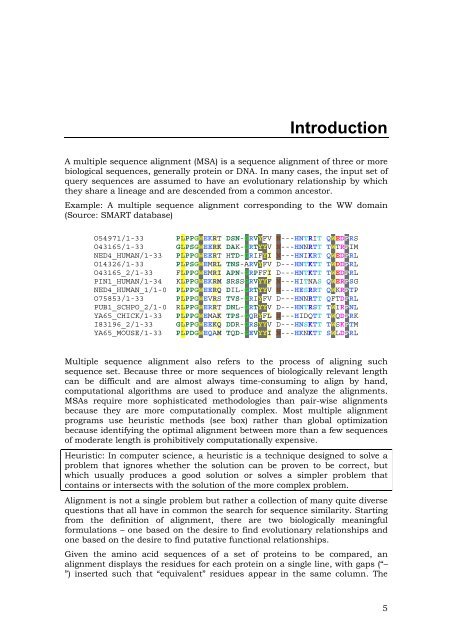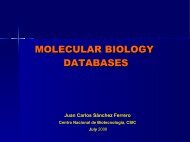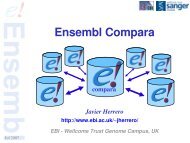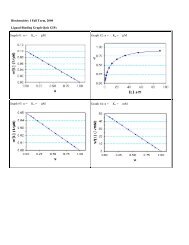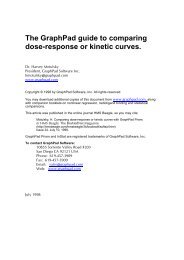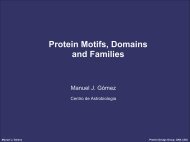Practical Course on Multiple Sequence Alignment - CNB - Protein ...
Practical Course on Multiple Sequence Alignment - CNB - Protein ...
Practical Course on Multiple Sequence Alignment - CNB - Protein ...
You also want an ePaper? Increase the reach of your titles
YUMPU automatically turns print PDFs into web optimized ePapers that Google loves.
Introducti<strong>on</strong><br />
A multiple sequence alignment (MSA) is a sequence alignment of three or more<br />
biological sequences, generally protein or DNA. In many cases, the input set of<br />
query sequences are assumed to have an evoluti<strong>on</strong>ary relati<strong>on</strong>ship by which<br />
they share a lineage and are descended from a comm<strong>on</strong> ancestor.<br />
Example: A multiple sequence alignment corresp<strong>on</strong>ding to the WW domain<br />
(Source: SMART database)<br />
O54971/1-33 PLPPGWEKRT DSN-GRVYFV N---HNTRIT QWEDPRS<br />
O43165/1-33 GLPSGWEERK DAK-GRTYYV N---HNNRTT TWTRPIM<br />
NED4_HUMAN/1-33 PLPPGWEERT HTD-GRIFYI N---HNIKRT QWEDPRL<br />
O14326/1-33 PLPSGWEMRL TNS-ARVYFV D---HNTKTT TWDDPRL<br />
O43165_2/1-33 FLPPGWEMRI APN-GRPFFI D---HNTKTT TWEDPRL<br />
PIN1_HUMAN/1-34 KLPPGWEKRM SRSSGRVYYF N---HITNAS QWERPSG<br />
NED4_HUMAN_1/1-0 PLPPGWEERQ DIL-GRTYYV N---HESRRT QWKRPTP<br />
O75853/1-33 PLPPGWEVRS TVS-GRIYFV D---HNNRTT QFTDPRL<br />
PUB1_SCHPO_2/1-0 RLPPGWERRT DNL-GRTYYV D---HNTRST TWIRPNL<br />
YA65_CHICK/1-33 PLPPGWEMAK TPS-GQRYFL N---HIDQTT TWQDPRK<br />
I83196_2/1-33 GLPPGWEEKQ DDR-GRSYYV D---HNSKTT TWSKPTM<br />
YA65_MOUSE/1-33 PLPDGWEQAM TQD-GEVYYI N---HKNKTT SWLDPRL<br />
<strong>Multiple</strong> sequence alignment also refers to the process of aligning such<br />
sequence set. Because three or more sequences of biologically relevant length<br />
can be difficult and are almost always time-c<strong>on</strong>suming to align by hand,<br />
computati<strong>on</strong>al algorithms are used to produce and analyze the alignments.<br />
MSAs require more sophisticated methodologies than pair-wise alignments<br />
because they are more computati<strong>on</strong>ally complex. Most multiple alignment<br />
programs use heuristic methods (see box) rather than global optimizati<strong>on</strong><br />
because identifying the optimal alignment between more than a few sequences<br />
of moderate length is prohibitively computati<strong>on</strong>ally expensive.<br />
Heuristic: In computer science, a heuristic is a technique designed to solve a<br />
problem that ignores whether the soluti<strong>on</strong> can be proven to be correct, but<br />
which usually produces a good soluti<strong>on</strong> or solves a simpler problem that<br />
c<strong>on</strong>tains or intersects with the soluti<strong>on</strong> of the more complex problem.<br />
<strong>Alignment</strong> is not a single problem but rather a collecti<strong>on</strong> of many quite diverse<br />
questi<strong>on</strong>s that all have in comm<strong>on</strong> the search for sequence similarity. Starting<br />
from the definiti<strong>on</strong> of alignment, there are two biologically meaningful<br />
formulati<strong>on</strong>s – <strong>on</strong>e based <strong>on</strong> the desire to find evoluti<strong>on</strong>ary relati<strong>on</strong>ships and<br />
<strong>on</strong>e based <strong>on</strong> the desire to find putative functi<strong>on</strong>al relati<strong>on</strong>ships.<br />
Given the amino acid sequences of a set of proteins to be compared, an<br />
alignment displays the residues for each protein <strong>on</strong> a single line, with gaps (“–<br />
”) inserted such that “equivalent” residues appear in the same column. The<br />
5


